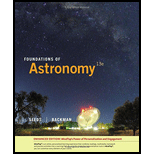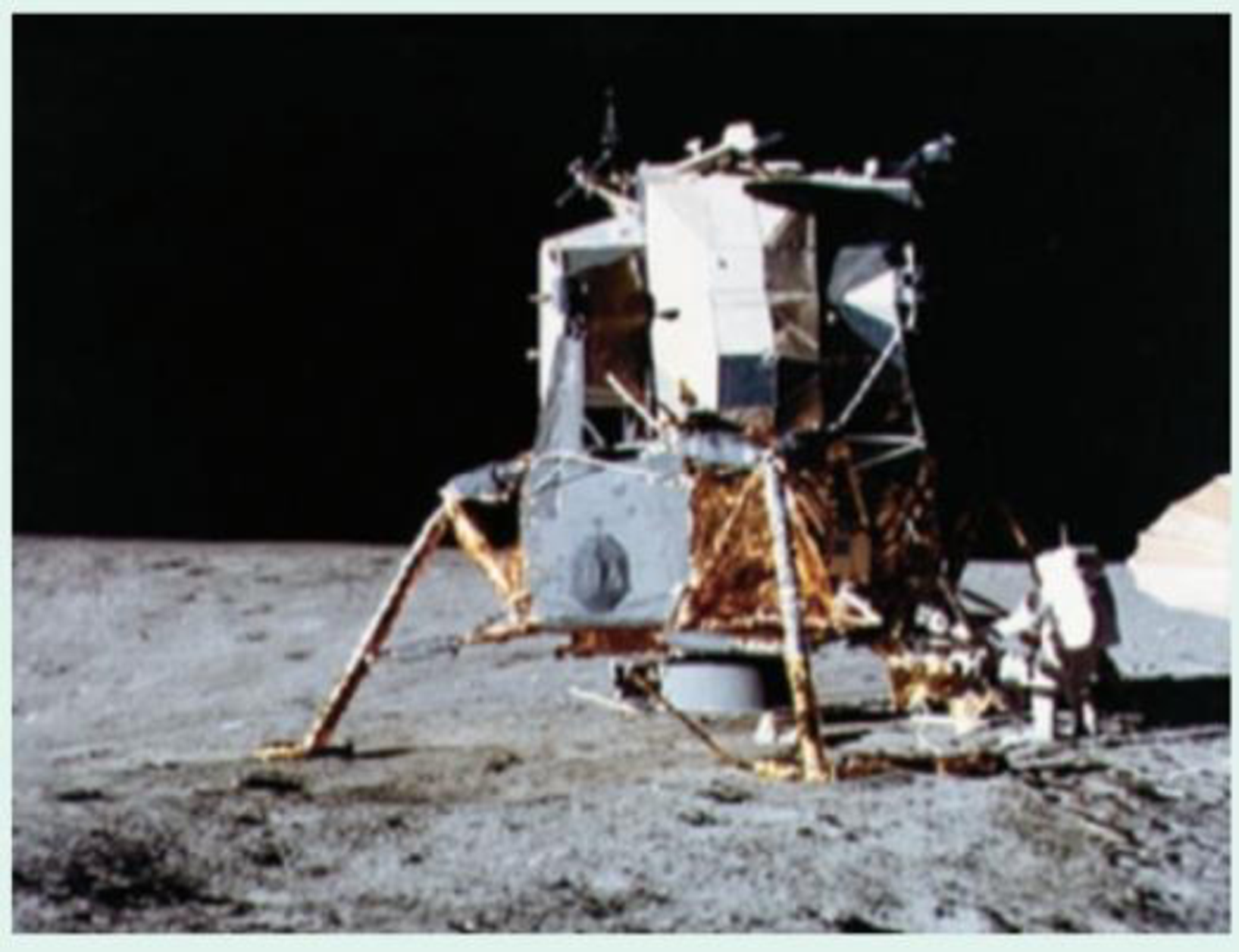
Foundations of Astronomy, Enhanced
13th Edition
ISBN: 9781305980686
Author: Michael A. Seeds; Dana Backman
Publisher: Cengage Learning US
expand_more
expand_more
format_list_bulleted
Textbook Question
Chapter 21, Problem 3LTL
In the photo shown here, astronaut Alan Bean works at the Apollo 12 lander. Describe the horizon and the surface you see. What kind of terrain did they land on for this, the second human Moon landing, and why?

Expert Solution & Answer
Trending nowThis is a popular solution!

Students have asked these similar questions
Please don't use Chatgpt will upvote and give handwritten solution
Please don't use Chatgpt will upvote and give handwritten solution
No chatgpt pls
Chapter 21 Solutions
Foundations of Astronomy, Enhanced
Ch. 21 - How does the force of gravity cause tidal coupling...Ch. 21 - As viewed from Earth, how many times does the Moon...Ch. 21 - If the Moon is tidally coupled to Earth, is Earth...Ch. 21 - How can you determine the relative ages of the...Ch. 21 - From looking at images of the Moons near side, how...Ch. 21 - Why did the first Apollo missions land on the...Ch. 21 - Why do planetary scientists hypothesize that the...Ch. 21 - Prob. 8RQCh. 21 - Prob. 9RQCh. 21 - Prob. 10RQ
Ch. 21 - What is the most significant kind of erosion that...Ch. 21 - Provide evidence to support a hypothesis about...Ch. 21 - What evidence can you cite that the Moon had...Ch. 21 - What evidence would you expect to find on the Moon...Ch. 21 - How does the large-impact hypothesis explain the...Ch. 21 - Look at the Celestial Profiles for Earth, the...Ch. 21 - Look at the Celestial Profiles for the Moon and...Ch. 21 - Prob. 18RQCh. 21 - Look at the Celestial Profiles for Earth, the...Ch. 21 - Look at the Celestial Profiles for the Moon and...Ch. 21 - Why are features like the Moons maria not observed...Ch. 21 - What are the relative ages of the intercrater...Ch. 21 - What evidence can you give that Mercury has a...Ch. 21 - Why is it not surprising that there is no evidence...Ch. 21 - What evidence can you give that Mercury had...Ch. 21 - How are the histories of the Moon and Mercury...Ch. 21 - What property of the Moon and Mercury has resulted...Ch. 21 - Prob. 28RQCh. 21 - Prob. 1DQCh. 21 - Prob. 2DQCh. 21 - Prob. 3DQCh. 21 - Prob. 4DQCh. 21 - Look at the right top and bottom images in Figure...Ch. 21 - Calculate the escape velocity of the Moon from its...Ch. 21 - Prob. 3PCh. 21 - Why do small planets cool faster than large...Ch. 21 - The smallest detail visible through Earth-based...Ch. 21 - Prob. 6PCh. 21 - The trenches where Earths seafloor slips downward...Ch. 21 - An Apollo command module orbited the Moon about...Ch. 21 - Prob. 9PCh. 21 - What is the angular diameter of Mercury when it is...Ch. 21 - If you transmit radio signals to Mercury when...Ch. 21 - What is the wavelength of the most intense...Ch. 21 - Suppose you send a probe to land on Mercury, and...Ch. 21 - The smallest detail visible through Earth-based...Ch. 21 - Look at the image of the astronaut on the Moon at...Ch. 21 - Examine the shape of the horizon at the Apollo 17...Ch. 21 - In the photo shown here, astronaut Alan Bean works...
Knowledge Booster
Learn more about
Need a deep-dive on the concept behind this application? Look no further. Learn more about this topic, physics and related others by exploring similar questions and additional content below.Similar questions
- Consider the situation in the figure below; a neutral conducting ball hangs from the ceiling by an insulating string, and a charged insulating rod is going to be placed nearby. A. First, if the rod was not there, what statement best describes the charge distribution of the ball? 1) Since it is a conductor, all the charges are on the outside of the ball. 2) The ball is neutral, so it has no positive or negative charges anywhere. 3) The positive and negative charges are separated from each other, but we don't know what direction the ball is polarized. 4) The positive and negative charges are evenly distributed everywhere in the ball. B. Now, when the rod is moved close to the ball, what happens to the charges on the ball? 1) There is a separation of charges in the ball; the side closer to the rod becomes positively charged, and the opposite side becomes negatively charged. 2) Negative charge is drawn from the ground (via the string), so the ball acquires a net negative charge. 3)…arrow_forwardanswer question 5-9arrow_forwardAMPS VOLTS OHMS 5) 50 A 110 V 6) .08 A 39 V 7) 0.5 A 60 8) 2.5 A 110 Varrow_forward
- The drawing shows an edge-on view of two planar surfaces that intersect and are mutually perpendicular. Surface (1) has an area of 1.90 m², while surface (2) has an area of 3.90 m². The electric field in the drawing is uniform and has a magnitude of 215 N/C. Find the magnitude of the electric flux through surface (1 and 2 combined) if the angle 8 made between the electric field with surface (2) is 30.0°. Solve in Nm²/C 1 Ө Surface 2 Surface 1arrow_forwardPROBLEM 5 What is the magnitude and direction of the resultant force acting on the connection support shown here? F₁ = 700 lbs F2 = 250 lbs 70° 60° F3 = 700 lbs 45° F4 = 300 lbs 40° Fs = 800 lbs 18° Free Body Diagram F₁ = 700 lbs 70° 250 lbs 60° F3= = 700 lbs 45° F₁ = 300 lbs 40° = Fs 800 lbs 18°arrow_forwardPROBLEM 3 Cables A and B are Supporting a 185-lb wooden crate. What is the magnitude of the tension force in each cable? A 20° 35° 185 lbsarrow_forward
- The determined Wile E. Coyote is out once more to try to capture the elusive Road Runner of Loony Tunes fame. The coyote is strapped to a rocket, which provide a constant horizontal acceleration of 15.0 m/s2. The coyote starts off at rest 79.2 m from the edge of a cliff at the instant the roadrunner zips by in the direction of the cliff. If the roadrunner moves with constant speed, find the minimum velocity the roadrunner must have to reach the cliff before the coyote. (proper sig fig in answer)arrow_forwardPROBLEM 4 What is the resultant of the force system acting on the connection shown? 25 F₁ = 80 lbs IK 65° F2 = 60 lbsarrow_forwardThree point-like charges in the attached image are placed at the corners of an equilateral triangle as shown in the figure. Each side of the triangle has a length of 38.0 cm, and the point (C) is located half way between q1 and q3 along the side. Find the magnitude of the electric field at point (C). Let q1 = −2.80 µC, q2 = −3.40 µC, and q3 = −4.50 µC. Thank you.arrow_forward
- STRUCTURES I Homework #1: Force Systems Name: TA: PROBLEM 1 Determine the horizontal and vertical components of the force in the cable shown. PROBLEM 2 The horizontal component of force F is 30 lb. What is the magnitude of force F? 6 10 4 4 F = 600lbs F = ?arrow_forwardThe determined Wile E. Coyote is out once more to try to capture the elusive Road Runner of Loony Tunes fame. The coyote is strapped to a rocket, which provide a constant horizontal acceleration of 15.0 m/s2. The coyote starts off at rest 79.2 m from the edge of a cliff at the instant the roadrunner zips by in the direction of the cliff. If the roadrunner moves with constant speed, find the minimum velocity the roadrunner must have to reach the cliff before the coyote. (proper sig fig)arrow_forwardHello, I need some help with calculations for a lab, it is Kinematics: Finding Acceleration Due to Gravity. Equations: s=s0+v0t+1/2at2 and a=gsinθ. The hypotenuse,r, is 100cm (given) and a height, y, is 3.5 cm (given). How do I find the Angle θ1? And, for distance traveled, s, would all be 100cm? For my first observations I recorded four trials in seconds: 1 - 2.13s, 2 - 2.60s, 3 - 2.08s, & 4 - 1.95s. This would all go in the coloumn for time right? How do I solve for the experimental approximation of the acceleration? Help with trial 1 would be great so I can use that as a model for the other trials. Thanks!arrow_forward
arrow_back_ios
SEE MORE QUESTIONS
arrow_forward_ios
Recommended textbooks for you
 Foundations of Astronomy (MindTap Course List)PhysicsISBN:9781337399920Author:Michael A. Seeds, Dana BackmanPublisher:Cengage Learning
Foundations of Astronomy (MindTap Course List)PhysicsISBN:9781337399920Author:Michael A. Seeds, Dana BackmanPublisher:Cengage Learning
 AstronomyPhysicsISBN:9781938168284Author:Andrew Fraknoi; David Morrison; Sidney C. WolffPublisher:OpenStax
AstronomyPhysicsISBN:9781938168284Author:Andrew Fraknoi; David Morrison; Sidney C. WolffPublisher:OpenStax
 Horizons: Exploring the Universe (MindTap Course ...PhysicsISBN:9781305960961Author:Michael A. Seeds, Dana BackmanPublisher:Cengage Learning
Horizons: Exploring the Universe (MindTap Course ...PhysicsISBN:9781305960961Author:Michael A. Seeds, Dana BackmanPublisher:Cengage Learning An Introduction to Physical SciencePhysicsISBN:9781305079137Author:James Shipman, Jerry D. Wilson, Charles A. Higgins, Omar TorresPublisher:Cengage Learning
An Introduction to Physical SciencePhysicsISBN:9781305079137Author:James Shipman, Jerry D. Wilson, Charles A. Higgins, Omar TorresPublisher:Cengage Learning

Foundations of Astronomy (MindTap Course List)
Physics
ISBN:9781337399920
Author:Michael A. Seeds, Dana Backman
Publisher:Cengage Learning


Astronomy
Physics
ISBN:9781938168284
Author:Andrew Fraknoi; David Morrison; Sidney C. Wolff
Publisher:OpenStax


Horizons: Exploring the Universe (MindTap Course ...
Physics
ISBN:9781305960961
Author:Michael A. Seeds, Dana Backman
Publisher:Cengage Learning

An Introduction to Physical Science
Physics
ISBN:9781305079137
Author:James Shipman, Jerry D. Wilson, Charles A. Higgins, Omar Torres
Publisher:Cengage Learning
Kepler's Three Laws Explained; Author: PhysicsHigh;https://www.youtube.com/watch?v=kyR6EO_RMKE;License: Standard YouTube License, CC-BY